Chronicon Pictum

The Chronicon Pictum (Latin for illustrated chronicle, English: Illuminated Chronicle or Vienna Illuminated Chronicle, Hungarian: Képes Krónika also referred to as Chronica Hungarorum, Chronicon (Hungariae) Pictum, Chronica Picta or Chronica de Gestis Hungarorum) is a medieval illustrated chronicle from the Kingdom of Hungary from the second half of fourteenth century. It represents the international artistic style of the royal courts in the court of Louis I of Hungary.
Its full name is: Chronicon pictum, Marci de Kalt, Chronica de gestis Hungarorum, that is Illustrated Chronicle, Mark of Kalt's Chronicle About the Deeds of the Hungarians.
History of the chronicle
The chronicle was written by Márk Kálti (lat. Marci de Kalt) shortly after the year 1358, with the last of the illuminations being finished between 1370 and 1373. The chronicle was given by the Hungarian king Louis I. to French king Charles V. when the daughter of Louis, Catherine, was engaged to Charles' son Louis.[1]
It was then gifted to Đorđe Branković in 1456, where it was copied, and later lost, possibly spending some time in Turkish possession.[1]
The chronicle reappears in the first half of the 17th century in royal archives of Vienna by unknown means, this is why it is also referred as "Vienna Illuminated Chronicle". The manuscript is now kept in the National Széchényi Library in Budapest (Országos Széchényi Könyvtár, Budapest).[1]
Depicted history
The 147 pictures of the chronicle are great source of information on medieval Hungarian cultural history, costume, and court life in the 14th century. Many miniatures seen inside this chronicle are painted with gold. The artistic value of the miniatures are quite high, if we compare similar miniatures from other parts of Western Europe from the same time. The characters are drawn with detail and with knowledge of anatomy. Even the eyeballs are painted, which can only be checked through microscope.
All miniatures showing Attila the Hun are disrupted or even rubbed out (especially the last, showing Attila's death); this cannot be due to the time as all other miniatures and text are preserved well. The miniatures make use of symbolism, i.e. "primus ingressus" ('first incoming') is with a camel, while the "secundus ingressus" ('second incoming') is with a white horse, probably meaning that entering the Carpathian Basin the first time was not a successful or was a culturally diverted act (as the camel is a "diverted" horse and white horse is the "pure quality"). The text of Latin is without error and is representing a high quality.
Gallery
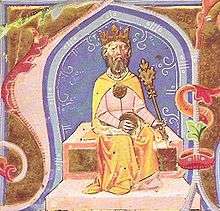

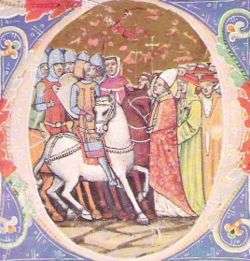
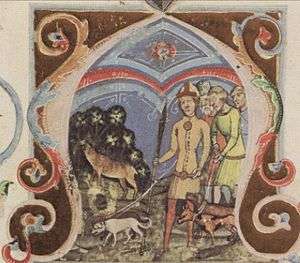

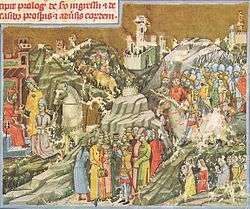

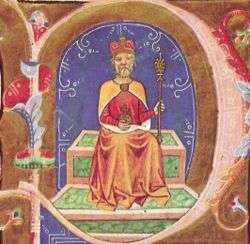 Grand Prince Géza
Grand Prince Géza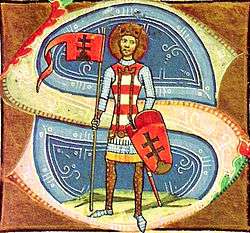 King St. Stephen
King St. Stephen King Ladislaus I
King Ladislaus I King Ladislaus I
King Ladislaus I King Coloman
King Coloman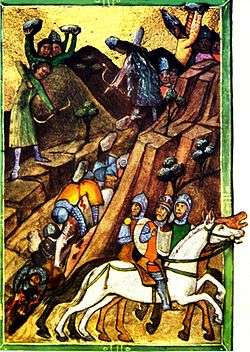
 King Béla IV
King Béla IV
External links
| Wikimedia Commons has media related to Chronicon Pictum. |
- A digitized version of the Chronicon itself at the Wayback Machine (archived March 4, 2012)
- Podhradczky József (1838) [1365]. Chronicon Budense (in Latin). Buda. – A more readable Latin text, with notes in Latin
- Geréb László (1993). Képes Krónika (in Hungarian). Magyar Hírlap and Maecenas. ISBN 963 8164 07 7. – Hungarian translation at the Hungarian Electronic Library
References
- 1 2 3 Pražák, Nechutová, Bartoňková (1988). Legendy a kroniky koruny Uherské (Legends and chronicles of Hungarian crown). Prague: Nakladatelství Vyšehrad. pp. 340–346.